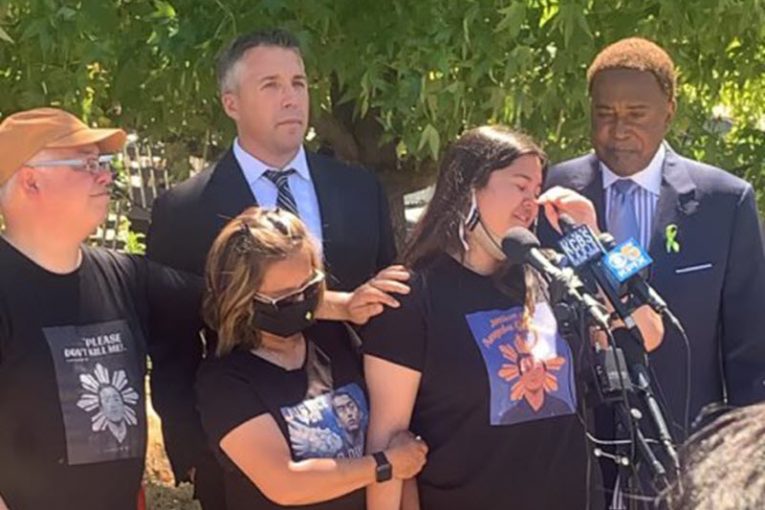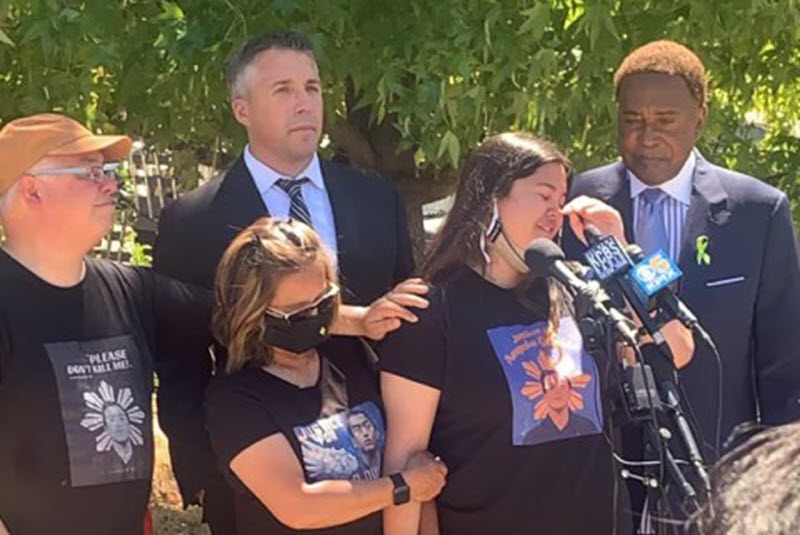

By Jessica Pishko
In December of 2020, Bella Collins called the Antioch Police Department for help with her brother Angelo Quinto, who appeared to be having a mental health crisis. Quinto was a Navy veteran who had been struggling with anxiety and depression, according to his family. When two Antioch police officers came, Maria Quinto-Collins was holding her son in a “bear hug” pose as a way to calm him and prevent him from injuring himself or others.
The officers entered the room and pulled Quinto to his feet. Quinto cried out, “Please don’t kill me!” One officer and then another knelt on Quinto’s neck until he became unresponsive; when they rolled him over, blood was coming out of his mouth, staining the floor.
Quinto died a few days later in the hospital. He never regained consciousness.
The family of Angelo Quinto is suing the Antioch Police Department for killing him, arguing that the police had choked him to death. But, the county and police officially deemed his death as caused by the questionable catch-all of “excited delirium.”
How did this happen?
In Contra Costa Country, every “officer-involved” death – meaning someone who died at the hands of the police or in jail – leads to a procedure called a coroner’s inquest. Not unlike a trial or grand jury, the coroner’s inquest allows for the presentation of evidence to a judge and jury of ordinary citizens, who then decide on the cause of death: natural, suicide, accident, or “by the hands of another other than accident.”
The biggest difference, however, between a coroner’s inquest and a judicial proceeding is that there is only one side. Evidence is presented by the county officials, and no one else can present contradictory or other  evidence.
evidence.
During the Quinto inquest, only the pathologist Dr. Ikechi Ogan and the police officers testified. Dr. Ogan, who conducted the autopsy, argued that certain physical markers did not indicate asphyxiation (another autopsy found different evidence), and pointed out that the presence of certain drugs in Quinto’s system led to his conclusion that his death was from “excited delirium,” even though, Dr. Ogan conceded, “excited delirium” is “poorly understood.”
While coroner’s inquests are one way to ensure accountability for police killings and negligence resulting in death, they are far from perfect and rely on the same system which ensnares people and puts them in harm’s way in the first place.
In death, as in life, a series of local and poorly-tracked regulations and procedures decide how a death is categorized. Faux-diagnoses like “excited delirium” are more likely to appear in reports and decisions that are sympathetic with the police. This comes from a combination of a policing system that seeks to blame victims for their own death, a death investigation system that grossly favors law enforcement interests, and a push by police-oriented experts who use their authority to endorse bad science like “excited delirium.”
“Excited delirium,” as described by experts and some pathologists, is a general term used for a heightened state of rage often caused by illegal drugs or mental illness. It’s basically a way of saying someone entered into an inexplicable rage, increasing their heart rate and stopping the heart suddenly, causing death. But, most credible medical experts don’t think the syndrome exists. One forensic pathologist called it “fictitious.” The American Medical Association recently came out against recognizing it as a valid diagnosis; “excited delirium” does not appear in any manual on psychiatric disordered, including the DSM. Even a review of the papers purporting to explain the syndrome point out that there are no consistent markers.
One reason to believe the critics of “excited delirium” is its history. Originally used by 19th century mental health professionals to describe convulsions of unknown origin, it gained a second life when a forensic pathologist used the term to describe sudden deaths of cocaine users. It was revived by Axon, the company that makes tasers (which are often involved in so-called “excited delirium” deaths), that began to market expert testimony on “excited delirium” to refute claims that people were being killed by police. University of Miami medical researcher Dr. Deborah Mash, for example, has published academic research arguing that excited delirium is real; she was also paid by Axon to testify as an expert witness, pointing a finger at “excited delirium” in lieu of tasers for suspicious deaths. (According to a Reuter’s investigation, Mash was collecting brain tissue to examine for signs of “excited delirium” during the same time period she was testifying on behalf of Axon.)
As with the Quinto case, cases of “excited delirium” are often reserved for situations that involve people in a mental health crisis was a way to avoid liability. One 2009 white paper describes people experiencing “excited delirium” as lacking “remorse, normal fear and understanding of surroundings…rational thoughts for safety are absent in such subjects.” Ideas that people in the throes of “excited delirium” don’t feel pain can lead police officers to use excessive force – like kneeling on someone’s neck for several minutes – killing people.
And while coroner’s inquests can allow for the presentation of evidence when a law enforcement office or department is refusing to cooperate, given the lack of coroner oversight, there are serious problems with it as well.
For one thing, the inquest is a limited hearing that does not allow the presentation of all evidence. As Quinto’s case shows, if medical examiners and police align on a narrative of “excited delirium” (backed by research from Axon-endorsed experts), there is no opportunity to argue otherwise or for other witnesses to testify as to what they saw or recorded. The Antioch police were not wearing body cameras, although Quinto’s mother recorded a cell phone video that was admitted into the inquest. Neither were other family members asked about what they saw. An independent autopsy conducted at the behest of attorney John Burris, who is representing the family in a civil rights lawsuit, found that the manner of death was “restraint asphyxiation.”
Second, in Contra Costa, as in 49 California counties, the sheriff is also the coroner, which increases the perception of a conflict of interest. In San Joaquin County, a medical examiner revealed that the sheriff was pressuring him and others to alter cause of death findings in order to exonerate law enforcement officers. While a medical examiner or pathologist conducts autopsies and documents their findings, the sheriff-coroner has the ability to change the official manner of death from “homicide” to “accident” or vice versa. Even when the conflict is not as dramatic, there are still problems. (San Joaquin separated the sheriff and coroner’s offices after such wrongdoing was exposed.) A relatively recent change in San Bernardino County, which combined the sheriff and coroner’s offices, means that coroner announcements now no longer provide any details about the incident, in order to avoid any conflicts with what the sheriff’s office might say.
Even when the sheriff is not involved directly in death determinations, there is ample evidence to show that the process is far from neutral. In the hands of county officials, who have every reason to protect the police, there is no pathway for the public or family members of the deceased to know what actually happened. One recent study conducted by Justin Feldman at Harvard found that coroners didn’t classify police killings as such in over half of all cases because of “errors.” some states were worse than others. And, worst of all, the inquest process is conducted as if the family members and loved ones do not exist; their testimony is not considered worthwhile even when they were witnesses to the events. This furthers the damage done by police violence and failure to care for people in crisis.
For now, the family of Angelo Quinto is seeking justice by suing the Antioch police department for excessive violence that directly led to his death. In a recent interview, Bella Collins, Quinto’s sister, explained that she watched the inquest with a sense of dismay. “It was interesting to see the amount of bias [during the inquest],” she explained in a recent interview. “[We were the] two key first-hand witnesses, and they didn’t refer to us by name a single time.”
Jessica Pishko is a lawyer, writer and researcher who focuses on sheriffs.






My name is Jimmy Lee, Public Information Officer for the Contra Costa Sheriff’s Office.
We are deeply concerned about this commentary – The Death Decision – Coroner’s Inquests and the Search for the Truth – which was written by Jessica Pishko. This commentary contained information that was misleading, incorrect and blatantly false.
Here are our concerns:
-The writer seems to confuse manner of death with cause of death. The two are very different. The coroner’s inquest jury rules on the manner of death, not the cause of death. The inquest jury can select from one of the following manners: natural, suicide, accident, and at the hands of another, other than by accident.
-The forensic pathologist decides on the official cause of death after conducting an autopsy and investigation. Although a forensic pathologist may testify at an inquest, his/her work is separate from the coroner’s inquest process. It should be noted that the forensic pathologists who conduct autopsies in Contra Costa County are independent and not employees of the Sheriff’s Office.
-In the case the writer refers to, the coroner’s inquest jury ruled that the manner of death was accident. The forensic pathologist separately determined the cause of death to be excited delirium.
-The commentary stated, “…the sheriff-coroner has the ability to change the official cause of death from “homicide” to “accident” or vice versa.” This is false. The ruling by the coroner’s inquest jury is final. Jurors, who are selected from the jury pool, deliberate before reaching a ruling.
-The commentary stated, “…mother recorded a cell phone video that did not get admitted into the inquest.” In fact, that video was played for the inquest jurors and public, along with the 9-1-1 call made by the family.
-The commentary stated that the inquest is run by “county officials.” This is false. An independent local attorney is hired as the hearing officer for the inquest.
I wanted to use this opportunity to clarify the false and misleading information in the commentary. Thank you for your time.
Thank you Mr. Lee for the clarification, we have updated the article to clarify several of the points.